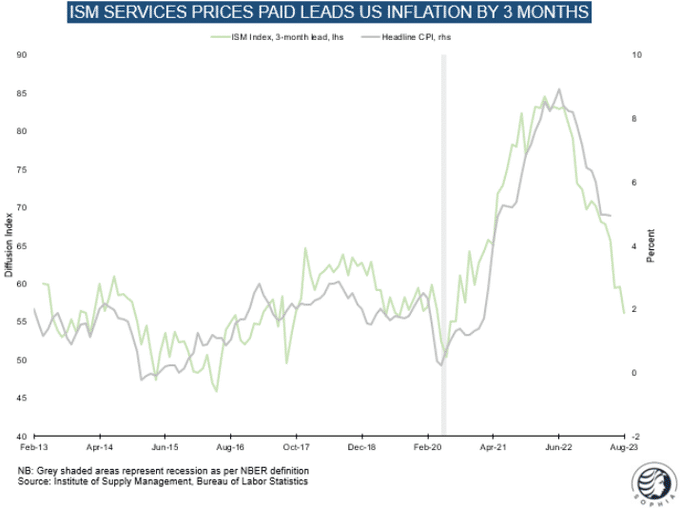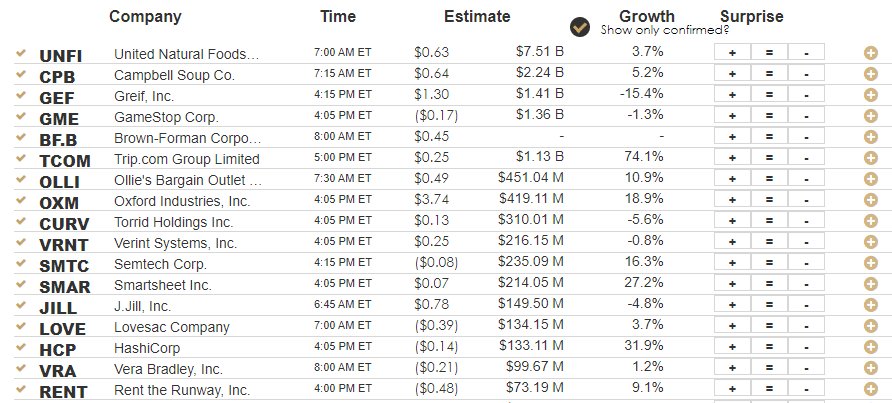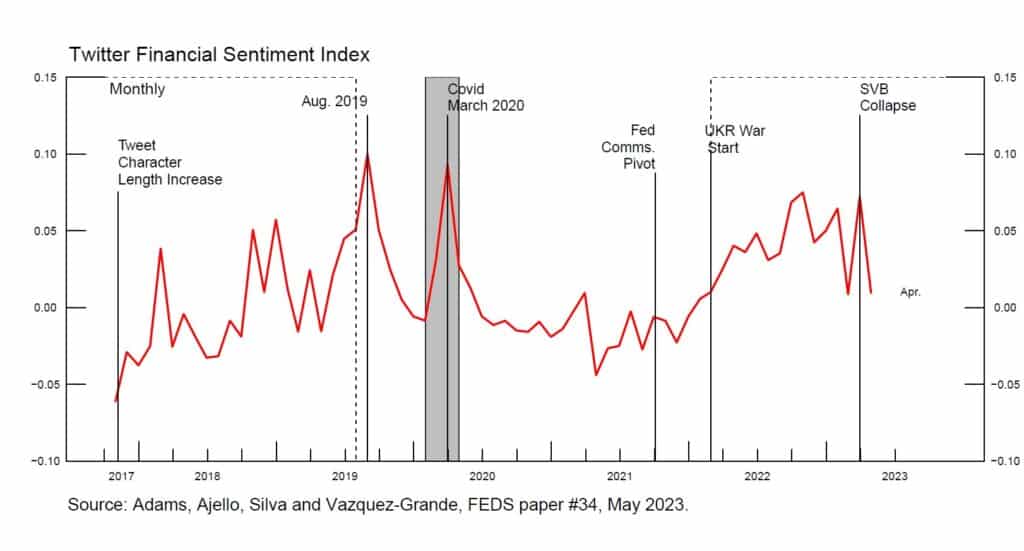The ISM manufacturing and service sector surveys are robust leading economic indicators as they provide a near real-time gauge of the sentiment of industry leaders. As we noted last week, the ISM manufacturing survey has pointed to economic contraction for nine consecutive months. The service sector, however, accounting for three-quarters of economic activity, has been relatively strong. That may be changing. Monday’s ISM service sector survey surprisingly fell to 50.3 and sits on the cusp of economic contraction. Within the report was some good news and some concerning results.
First, the good news. Prices paid fell 3.4 points. There are still more respondents thinking prices will be higher than lower, but the difference is narrowing as it has been for a year. The graph below, from SophiaKnowledge, shows the ISM services prices paid index tends to lead CPI by three months. If the relationship continues, we expect CPI to reach the Fed’s 2% target later this summer. Remember, the latest manufacturing prices paid index fell sharply from 53.2 to 44.2. Now the bad news. The backlog of orders fell sharply, and new orders declined but are still in economic expansion territory. These sub-components are good leading indicators and may hint that the ISM service sector may soon follow manufacturing into contractionary territory. Also, employment slipped below 50, another potential warning of weaker economic growth later this year.

What To Watch Today
Earnings

Economy

Market Trading Update – The VIX Is In A Correction Zone
The volatility index (VIX) has been a good indicator of market corrections in both bull and bear markets. Sometimes those corrective actions can be just a sideways market for a period of time, or they can be decent selloffs of 5-10%. The volatility index is trading at the lowest levels we have seen since the stimulus-fueled runup into the January 2022 peak. While an extremely low VIX reading does not mean the market will correct today or even over the next couple of weeks, it does suggest that complacency has increased to levels where any disappointing event can lead to a decent price reversal in the market.
As such, we suggest taking profits in stocks that have run up a lot over the last couple of months (Technology, Communications, and Discretionary) and watching for a short-term rotation into stocks that have lagged the index this year (pretty much everything else.) With the Federal Reserve on deck next week, a more hawkish posture by Jerome Powell could take the wind out of the Cyclical trade short-term. We will have to wait and see.


Apple VR Headsets Hit the Market
Apple introduced its virtual reality (VR) headset. At an initial price of $3,499, the headsets are priced well above competing brands and are likely too expensive for most consumers. Some pundits claim that the high price may make the product a dud. We remind you Apple has a strong track record of providing products that are not only among the most pricey but best in class and heavily demanded by the public. For instance, many questioned the value of an Apple iWatch because many potential consumer bases already owned iPhones with greater capabilities than the watch. It now sells 40 million annually, accounting for nearly 50% of digital watch sales. In 2007, Apple introduced the iPhone. That year they sold a total of 1.7 smartphones. They now sell 1.7 million every two days!
The following LINK clicks to a short video on the headset and shows its capabilities. As prices decrease and VR technology becomes more desired, Apple will likely be among the industry leaders in this new technology.

Bitcoin Sinks as Binance and Coinbase Under SEC Attack
Coinbase fell over 20% on Tuesday as the SEC charged the company with unlawfully acting as an unregistered exchange, broker, and clearing agency. The day prior, Binance was charged by the SEC for similar practices. Per SEC Chair Gary Gensler, Binance was engaging in an “extensive web of deception.”
In the wake of the FTC default and regulation failure, the SEC is finally cracking down on cryptocurrency trading and forcing any exchanges, including trading and clearing practices, to be registered and approved with the SEC. T-Zero is the only SEC registered and approved digital securities exchange in the United States. T-Zero is jointly held by Overstock (OSTK) and International Exchange Inc. (ICE).

Is Twitter Driving Monetary Policy?
Some of our daily Tweets of the Day may be more important than you think. The Fed recently published a white paper entitled Twitter Chatter and Financial Market Sentiment. The paper describes a new model the Fed built, which gauges market sentiment based on Twitter data. Market sentiment plays a big role in setting monetary policy. Therefore, following Twitter may prove more beneficial than you think. However, the problem is that most of us follow like-minded people, making it hard to appreciate broad market sentiment using Twitter.
Per the paper’s abstract:
We find that the Twitter Financial Sentiment Index (TFSI) correlates highly with corporate bond spreads and other price- and survey-based measures of financial conditions. We document that overnight Twitter financial sentiment helps predict next day stock market returns. Most notably, we show that the index contains information that helps forecast changes in the U.S. monetary policy stance: a deterioration in Twitter financial sentiment the day ahead of an FOMC statement release predicts the size of restrictive monetary policy shocks. Finally, we document that sentiment worsens in response to an unexpected tightening of monetary policy.

Tweet of the Day

Please subscribe to the daily commentary to receive these updates every morning before the opening bell.
If you found this blog useful, please send it to someone else, share it on social media, or contact us to set up a meeting.
Post Views: 0
2023/06/07




